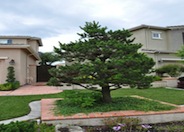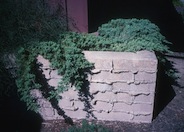
Common name:Eastern Redbud
Botanical name:Cercis canadensis
This small, deciduous tree with a rounded head is covered with small flowers of a rose pink color in the spring before the appearance of heart-shaped leaves. It can grow to 25' tall with an equal spread. It has a low branching habit with a rounded form. During fall, foliage turns yellow. Eastern Redbud lives about 20 years. This is a great patio tree or for a small front yard.

Common name:Japanese Black Pine
Botanical name:Pinus thunbergii
This variety of pine is both rigid and twisted, with needles of 3"-4". It has an irregular shape, and the short, contorted branches produce a canopy-shaped tree. The buds are white, and the cones are egg-shaped and without prickles.

Common name:Snow-In-Summer
Botanical name:Cerastium tomentosum
Masses of snow white flowers highlight this plant during the early summer season. This attractive ground cover is a great filler among other plants and rocks. Foliage is silver gray or gray/green and is woolly. This plant tolerates coastal conditions and desert areas. Use in rock settings, in hanging baskets, containers, or as a lawn substitute. Cut back in fall to refresh plant.

Common name:Coast Redwood, Redwood
Botanical name:Sequoia sempervirens
This fast-growing, aromatic tree has soft, dark green foliage with long needles appearing in flat sprays and brown, barrel-shaped cones that appear after 1 year. Its soft, red-brown bark is fiberous and furrowed. Particularly after mechanical damage, this tree will stump sprout to form new, young trees around the stump. Avoid planting in areas of high foot traffic.

Common name:Dwarf Lily of the Nile
Botanical name:Agapanthus 'Peter Pan'
This clumping dwarf variety of Agapanthus has green, strap-like, evergreen leaves. Clusters of blue, oval shaped flowers appear in summer on top of stalks, making this plant about 2' tall. This dependable plant can be grown in sun or partial sun. It is drought tolerant in coastal areas but will appreciate occasional watering in inland warm areas, especially during the summer. This perennial attracts butterflies.

Common name:Nandina, Heavenly Bamboo
Botanical name:Nandina domestica
Nandina domestica is a graceful upright shrub that grows from 3'-6' in height. It gets its name from its bamboo-like growth habit. When thinned from the center it bears a remarkable resemblance to bamboo. It is best used in groups. It can be used in a shaded patio or out in a shrub border with full sun. An interesting feature of Heavenly Bamboo is the bronze color in the new growth when planted in full sun. It also bears clusters of white flowers in the spring.

Common name:Variegated Japanese Sedge
Botanical name:Carex oshimensis 'Evergold'
This low-growing, clumping grass consists of green leaves that each have a broad yellow stripe down the center.

Common name:Dwarf Japanese Garden Juniper
Botanical name:Juniperus procumbens 'Nana'
The very dense growth of this plant is highlighted by foliage of a bluish-green color. Its growth habit is very low, spreading, and mound-like -- resembling a natural bonsai. One of the best Junipers for small garden spaces.

Common name:Japanese Black Pine
Botanical name:Pinus thunbergii
This variety of pine is both rigid and twisted, with needles of 3"-4". It has an irregular shape, and the short, contorted branches produce a canopy-shaped tree. The buds are white, and the cones are egg-shaped and without prickles.

Common name:Rosemary
Botanical name:Rosmarinus officinalis
Rosemary is hardy in full sun areas where winter temperatures do not drop below 10 degrees F. Rosemary is evergreen and makes a great aromatic hedge, 4'-6' tall and 2' wide. Foliage is used in cooking. Blue flowers appear in summer. This plant is drought tolerant once it's established. Bees love Rosemary!

Common name:Amazing Red N.Z. Flax
Botanical name:Phormium 'Amazing Red'
Phormium 'Amazing Red' is an evergreen perennial. This plant has many swordlike, stiffly vertical leaves in a fan pattern, reaching 2' tall. Leaves are reddish brown. Flowers are insignificant and bloom infrequently. It does better with occasional watering once it's established.
Dry creek bed and catch basin gives water a chance to percolate into the soil before being passed out to the street.